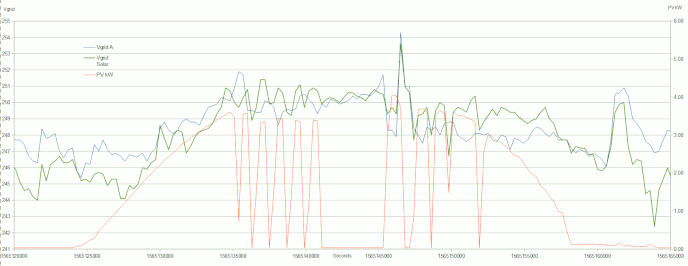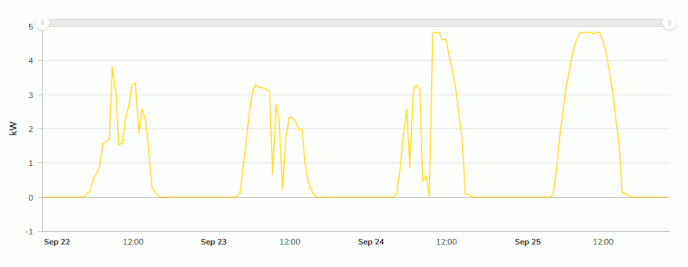SUMMARY
Many rooftop PV systems around the country are having their output restricted or being cut off completely due to high grid voltage.
This is costing PV system owners money in a double whammy: lost income from energy exports (grid feed-in), and also having to unnecessarily pay for imported energy when the inverter is shut down due to over-voltage.
The Australian standard has been 230V since 2000, yet many houses experience near 250V much of the time. This leaves little leeway before inverters shut down due to over-voltage.
The operators of the grid at local street level require solid evidence before they will take action to adjust voltage to more inline with the standard.
Monitoring of your system is one way to gather the required evidence for a remedy.
Here is my experience with fixing this problem for my brother.
Often you hear of people who think that solar power is a rip-off, with claims that power bills have not reduced, or even increased, since a PV system was installed on the roof. I’m pretty sure that none of these people have decent monitoring of their system, so they are unable to determine what is going on.
Of course there are factors other than high grid voltage that can contribute to low or zero power being produced- panel shading, poorly located hot inverters in direct sunlight, water filled rooftop isolators, badly made or corroded connections etc. Monitoring will alert system owners to all of these issues.
However, for systems that are properly functional the major cause for poorly performing systems has to be high grid voltage. Inverters reduce output, then shut down completely when grid voltage gets into the 250-253V range. 253V is meant to be the upper limit, 230V + 10%.
A number of analytical companies and various studies have shown via their monitoring across a large number of PV systems around the country, that the majority of systems experience voltages well above the Australian standard 230V. Very few experience low voltage below the minimum standard of 216V (230V - 6%) these days.
My NSW Central Coast dwelling brother recently had monitoring installed at his house, which has a 6.4kW PV/5kW inverter installed on one of the 2 phases connected to his house. He asked me to look into and see if I could sort out his system’s less than optimal performance issues.
The sampling interval of the PV system and various circuits shown on the web-based graphical display is 5 minutes, which hides the full extent of the problem. Certainly dropouts that last an extended period show up, but the multiple inverter restart attempts are hidden by the rather coarse sampling. Even so, it was clear that once exported power levels were up around 2.5-3kW, the inverter throttled back or shut down completely, often for hours on end. Not only does this mean loss of feed-in tariff, it means that grid power is being used to run household loads, which could have easily been covered by essentially free power generated on the roof- unavailable due to inverter shut-downs.
In addition to the graphical display there is a 5 second sample rate numerical display of the power levels in the 6 current transducers, plus grid voltage, measured at the switchboard at the front of the house. Watching that I could see that grid voltage was around 250V or more for much of the time, even overnight when there was no solar input. It was clear to me that the transformer needed to be set to a lower voltage tap on the output.
Discussing the issue with an electrical engineer at Ausgrid revealed that they do not have low voltage (415/230v) transformer voltage monitoring at all, and are essentially blind to what voltage their customers are experiencing. My suggestion that the transformer near my brother’s house needed to be adjusted to a lower voltage tap brought the response that they were concerned about low voltage at the end of the line. This, even though they had no evidence that it might be an issue!
Apparently something like 200 houses are supplied by the transformer, which is located quite close to my brother’s house. The engineer also suggested the problem was related to the solar power system at my brother’s house, raising the voltage too much. It was suggested that we check the settings on the inverter.
That was done, and the maximum grid voltage setting was adjusted up 3 volts to 258V. This allows for up to 5 volts rise in the cabling between the inverter and the front switchboard due to resistance in the wiring, which was 6mm^2 from inverter to the house sub switchboard, and then 16mm^2 to the front of the house. At the power levels involved, this size cabling is more than adequate to avoid voltage rise issues of any significance.
In any case, after the inverter settings were adjusted I could not see any improvements. Clearly the grid voltage was too high to begin with.
From my frequent monitoring of the 5 second voltage data, I knew that the voltage was often around 250V at night when no PV systems were exporting any power, so that the issue was definitely not due to my brother’s power exports. There are only a couple of other houses near my brother’s with small solar systems, and I suspect they may also have been experiencing inverter drop-outs, but probably don’t realise it due to not having monitoring. I am certain that this is the case for tens of thousands of houses across the country.
After some back and forth with Ausgrid, they agreed that they would consider a tap change on the transformer if I could provide evidence that the high grid voltage problem was not due to the exporting of power from my brother’s PV system.
So it was back to the monitoring company, with whom I’d had some discussions and correspondence up to that time to sort out some monitoring set-up issues. I requested voltage logs for both phases, along with the power levels from the various CTs for an extended period, and hopefully I’d be able to extract enough from that to convince Ausgrid.
The voltage log showed the maximum voltage during each 5 minute period, rather than an average, which may have hidden the peaks, however, the high voltage periods were sufficiently long anyway. The voltage showed some significant fluctuations- rather more than the stable voltages Ausgrid had suggested would be the case. I was able to plot some voltage traces showing high voltage on both phases, day and night, and since one of the phases did not have any PV system connected to it, it was enough evidence for Ausgrid to adjust the transformer. My reading of the data suggested that loads coming on and off were a much more significant factor than PV systems for the voltage fluctuations.
Graph of data from a day in mid August showing grid voltage, labelled Vgrid A - no PV system connected, and Vgrid Solar which has the 5kW inverter connected to it. The red trace shows gross output from the inverter, actual exports being fed to the grid are always less, due to self-consumption loads in the house.
Seconds on the x axis start from 1970! (that’s just how it came in the log file)
Note the voltage increase on both phases a bit after midday- to around 254V, plus the significant voltage excursions in both phases after the sun had set.
The 5 minute sampling interval means that the period through the middle of the day when output varies enormously doesn’t show a truly accurate picture of the durations of dropouts, or any attempted restarts. Voltages shown are the maximum during each 5 minute period.
This plot of gross inverter output shows the effect of having the grid voltage lowered to around 240V before midday on 24th September. With no more throttling and dropouts, it now functions as it should!
It is difficult to calculate with any accuracy how much this might be costing people over an extended period, but with complaints of no or minimal bill reductions after PV system installation, whilst others wipe out their entire bill, it can clearly be a significant loss. I encourage those with PV systems to have a good monitoring system installed- that will be the first step in discovering how your system is performing, and whether or not high grid voltage is costing you a significant amount.


